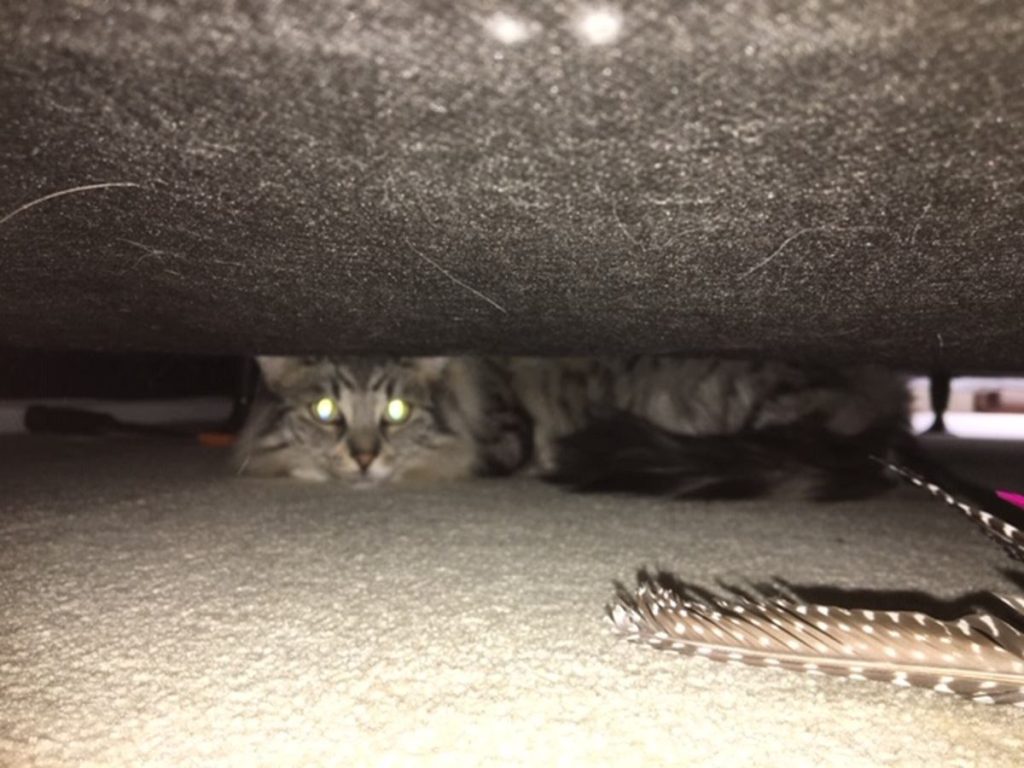How to Identify and Treat Behavioral Problems in Cats: Effective Strategies for Owners

The Behavior of Cats: An Exploration
Cats, often regarded as independent and enigmatic beings, can display a variety of behavioral issues that leave their owners puzzled. Recognizing these problems early is crucial for effective management and enhancing the overall well-being of both pet and owner. Understanding behavioral problems in cats not only improves the relationship between cats and their humans but also leads to a peaceful cohabitation.
Common Behavioral Problems
Each cat is unique, and as such, each may present different behavioral challenges. Here are some common issues many cat owners may face:
- Excessive meowing or yowling: Cats may vocalize more than usual for a variety of reasons, such as demands for attention, discomfort, or even as a sign of age-related cognitive decline.
- Inappropriate elimination: If a cat suddenly starts urinating or defecating outside the litter box, it can indicate health problems, stress, or dissatisfaction with the litter box conditions.
- Aggression: Whether directed towards humans or other pets, sudden aggression in a cat can stem from fear, territorial disputes, or play aggression gone too far.
- Destructive behavior: Cats love to scratch and explore, but if they begin to damage furniture or household items, it may indicate boredom or a need to sharpen their claws.
- Over-grooming or hiding: If a cat excessively grooms itself to the point of creating bald spots, or if it suddenly becomes reclusive, these can be signs of anxiety, stress, or underlying health issues.
Reasons Behind the Behavior
Understanding why these behaviors manifest is essential for proper intervention. Various factors may contribute to a cat’s behavioral problems:
- Stress: Changes in the household environment, such as moving, new family members, or even changes in routine can lead to significant stress in cats. An understanding of feline anxiety can help owners identify and address these triggers.
- Medical conditions: Sometimes behavioral changes can indicate underlying health issues, such as urinary tract infections, thyroid problems, or joint pain. Regular veterinary check-ups are vital for early detection and treatment.
- Lack of stimulation: Cats are natural hunters; if they lack engaging toys, scratching posts, or sufficient playtime with their owners, they may display boredom through destructive behaviors.
By closely observing their feline companions, cat owners can take proactive steps to manage these behaviors effectively. Incorporating more interactive playtime, providing enriched environments, and consulting with veterinarians when needed can all lead to significant improvements. In the upcoming sections, we will dive into specific actionable solutions to restore harmony and happiness within your home.
LEARN MORE: Click here for important insights

Identifying Behavioral Problems: The First Step to Resolution
Recognizing the signs of behavioral problems in cats is essential for any cat owner wishing to maintain a harmonious household. Cats are known for their nuanced behaviors, and understanding the subtle changes can be a game changer in not just addressing the issues but preventing them from escalating. Here, we will explore how to identify the most common behavioral problems, enabling you to take action before they become severe.
Observing Changes in Behavior
The first sign that something may be off with your feline friend often lies in their daily behavior. Owners should regularly observe their cat’s habits and demeanor. Behavioral changes may manifest in various ways:
- Social Interaction: A previously friendly cat that becomes withdrawn or aggressive can signal emotional distress or health issues. Conversely, a normally solitary cat that suddenly seeks excessive attention may also be in discomfort.
- Feeding Habits: Changes in eating behavior, such as refusal to eat or eating excessively, could indicate underlying health concerns or stressors in the environment.
- Play Behavior: If a cat that used to engage energetically in play suddenly loses interest, it could be a sign that they are feeling unwell or emotionally troubled.
It’s crucial to distinguish between temporary moods and more lasting behavioral shifts. A sudden change could be a response to minor disturbances, like a recent visit from a loud relative, but if these behaviors persist longer than a few days, it warrants further investigation.
Documenting Behavioral Patterns
Taking note of when and where these changes occur can provide significant insights into your cat’s state of mind. Keep a journal to document specific instances of concerning behavior along with potential triggers. You might notice a pattern emerging. For instance, excessive meowing may coincide with changes in your daily routine or the presence of new pets or people in the house.
This practice of observation can be particularly beneficial for identifying the root cause of issues like inappropriate elimination. Is the behavior linked to specific stresses in the household? Is the litter box clean and accessible? Asking these questions can help clarify the multitude of factors at play.
The Role of Environmental Enrichment
Environmental enrichment plays a significant role in a cat’s behavior. Boredom can lead to destructive behaviors as your cat seeks ways to stimulate itself. Owners can improve their cat’s mental and physical well-being by providing:
- Interactive Toys: Toys that encourage problem-solving can keep your cat mentally stimulated.
- Scratchers and Climbing Trees: Providing designated areas for scratching and climbing encourages natural behaviors while protecting household items.
- Playtime with Owners: Engaging in regular interactive play can strengthen bonds and fulfill your cat’s instinctual needs.
By understanding and documenting changes in behavior and enriching your cat’s environment, you can proactively manage behavioral problems before they escalate. In the subsequent sections, we will delve into specific treatment strategies and corrective measures to ensure a well-rounded approach to your cat’s mental health.
Recognizing Signs of Behavioral Problems in Cats
Identifying behavioral issues in cats can be challenging, as they are often subtle and vary from one feline to another. Common signs of distress include excessive meowing, hiding, aggression, litter box avoidance, and destructive behavior. It’s crucial for owners to pay close attention to any changes in their cat’s behavior. These changes can indicate not just behavioral issues, but also underlying health problems. Regular observation is key. If your cat seems unusually withdrawn or aggressive, or if you notice changes in their eating or grooming habits, it may be time to consult a veterinarian. Understanding the context of these behaviors can provide significant insights into their mental state and needs.
Effective Treatment Strategies
Once behavioral problems are identified, addressing them effectively requires a comprehensive approach. Here are some strategies that owners can implement:- Environmental Enrichment: Cats are naturally curious and need stimulation. Providing a variety of toys, scratching posts, and interactive playtime can help alleviate boredom and reduce stress, which can lead to negative behaviors.- Behavior Modification Techniques: Training your cat using positive reinforcement can help change undesirable habits. Rewarding good behavior with treats or affection encourages cats to repeat those behaviors.- Consulting a Professional: If behavioral issues persist, enlisting the help of a veterinarian or a certified animal behaviorist may be necessary. They can provide tailored advice and identify any potential medical conditions affecting behavior.- Consistency and Patience: Behavioral improvements take time. Maintaining a consistent routine and being patient with your cat is vital for success. Sudden changes or inconsistency can lead to increased anxiety and worsen behavioral problems.As you explore these strategies, remember that understanding your cat’s behavior is a crucial step in establishing a happy and healthy environment. Emphasizing the welfare of your feline companion will lead to a more fulfilling relationship for both owners and their beloved cats.
LEARN MORE: Click here for insights on virtual training
Effective Strategies for Treating Behavioral Problems in Cats
Once you’ve identified potential behavioral problems in your cat, the next step is to implement effective treatment strategies. These approaches can not only address the issues at hand but also foster a deeper connection between you and your feline companion. Here are key strategies that cat owners can employ to tackle behavioral challenges.
Consulting a Veterinarian
Before diving into behavioral interventions, a visit to the veterinarian is essential. Cats can exhibit behavioral problems due to underlying medical issues such as pain, infection, or hormonal imbalances. A thorough examination can rule out physiological causes and set the stage for appropriate treatment options. For example, diabetes or hyperthyroidism can manifest in behavioral shifts, and treating the medical condition may resolve the associated behaviors.
Implementing Positive Reinforcement
Behavioral modification techniques centered around positive reinforcement can be remarkably effective. This method encourages desirable behaviors through rewards, rather than punishing negative ones. For instance, if your cat learns to use the litter box appropriately, rewarding them with treats or affection reinforces that behavior. Similarly, if your cat is too aggressive during play, redirecting their energy to a toy and rewarding calm behavior can build a more positive association with playtime.
Creating a Safe Space
Environmental factors can significantly impact a cat’s behavior. If your feline is experiencing anxiety or stress, creating a designated safe space can make a world of difference. This area should be quiet, cozy, and filled with your cat’s favorite items, such as blankets or toys. Moreover, consider using pheromone diffusers or sprays designed to mimic the calming scents that cats naturally produce. These products can help sway your cat towards relaxation during stressful situations, such as during thunderstorms or fireworks.
Behavioral Modification Techniques
Utilizing behavioral modification techniques can help address common issues. For example, if territorial disputes arise due to the introduction of a new pet, employing gradual introductions can ease tension. This might involve swapping bedding between pets to familiarize them with each other’s scents before allowing face-to-face meetings. Additionally, strategies like clicker training can provide structure and clarity while teaching new behaviors.
Consistency is Key
Consistency is vital when modifying a cat’s behavior. Owners should maintain a steady routine in feeding, play, and grooming schedules to help their cat feel secure and reduce anxiety. Disruption in routine can lead to confusion and stress, exacerbating behavioral issues. Engaging family members in the same approach ensures that new strategies are uniformly applied, reinforcing the desired behaviors reliably.
Seek Professional Help
If behavioral problems persist despite your best efforts, it may be time to consider enlisting a professional, such as a feline behaviorist or a certified animal trainer. These experts can assess your cat’s behavior in detail and provide tailored strategies based on their observations and experience. They can also guide you through more advanced behavioral modification programs, ensuring that both you and your cat can thrive in a more peaceful environment.
By understanding how to identify behavioral problems and employing effective treatment strategies, cat owners can significantly improve their pet’s quality of life. The next steps revolve around building an enriching environment and fostering a strong bond—setting the stage for a happy and well-adjusted feline companion.
DISCOVER MORE: Click here to learn how to choose the best accessories for your pet’s health
Conclusion
Understanding how to identify and treat behavioral problems in cats is essential for their overall well-being and your peace of mind as an owner. By taking proactive steps, such as consulting a veterinarian and implementing positive reinforcement, you can not only address the issues your feline may face but also strengthen the bond between you and your pet. Remember, creating a safe environment is crucial; it allows your cat to feel secure, which can significantly reduce stress-induced behaviors.
Incorporating strategies like consistency in routines and seeking help from professionals—whether it’s a certified trainer or a feline behaviorist—can provide deeper insights and more advanced tools for behavioral modification. It’s important to recognize that while addressing behavioral issues may take time, the investment in understanding and patience pays off in the form of a happier and healthier cat.
Ultimately, fostering an enriching atmosphere, focusing on positive interactions, and being aware of your cat’s needs can profoundly improve their quality of life. As an owner, you have the power to champion your cat’s mental well-being by employing these effective strategies, thus transforming behavioral problems into opportunities for growth, understanding, and companionship. Remember, your journey to understanding your feline friend is ongoing, and every step you take contributes to a deeper, more fulfilling relationship.


